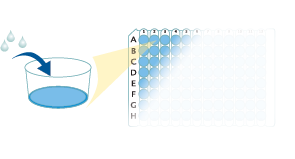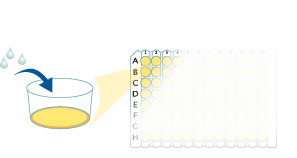Human CCL27/CTACK Quantikine ELISA Kit Summary
Product Summary
Precision
Cell Culture Supernates, Serum, EDTA Plasma, Heparin Plasma
| Intra-Assay Precision | Inter-Assay Precision | |||||
|---|---|---|---|---|---|---|
| Sample | 1 | 2 | 3 | 1 | 2 | 3 |
| n | 20 | 20 | 20 | 40 | 40 | 40 |
| Mean (pg/mL) | 127 | 241 | 559 | 129 | 242 | 557 |
| Standard Deviation | 4.79 | 9.05 | 28.4 | 16.1 | 21.5 | 33.8 |
| CV% | 3.8 | 3.7 | 5.1 | 12.5 | 8.9 | 6.1 |
Recovery
The recovery of CTACK spiked to levels throughout the range of the assay was evaluated.
| Sample Type | Average % Recovery | Range % |
|---|---|---|
| Cell Culture Media (n=4) | 97 | 91-105 |
Linearity
Scientific Data
Product Datasheets
Preparation and Storage
Background: CCL27/CTACK
CCL27, also known as Cutaneous T cell-attracting chemokine (CTACK), ALP, ILC and ESkine, is a CC chemokine discovered using expressed sequence tags (EST) in a homology search for novel chemokines. Mature human and mouse CCL27 are 84% similar. Mouse CCL27 shares 37% and 35% amino acid identity with mouse MIP-3 beta and mouse TECK, respectively. CCL27 is predominantly expressed in the skin. The expression is up-regulated by proinflammatory cytokines.
Assay Procedure
Refer to the product- Prepare all reagents, standard dilutions, and samples as directed in the product insert.
- Remove excess microplate strips from the plate frame, return them to the foil pouch containing the desiccant pack, and reseal.
- Add 100 µL of Assay Diluent to each well.
- Add 50 µL of Standard, control, or sample to each well. Cover with a plate sealer, and incubate at room temperature for 2 hours.
- Aspirate each well and wash, repeating the process 3 times for a total of 4 washes.
- Add 200 µL of Conjugate to each well. Cover with a new plate sealer, and incubate at room temperature for 2 hours.
- Aspirate and wash 4 times.
- Add 200 µL Substrate Solution to each well. Incubate at room temperature for 30 minutes. PROTECT FROM LIGHT.
- Add 50 µL of Stop Solution to each well. Read at 450 nm within 30 minutes. Set wavelength correction to 540 nm or 570 nm.





Citations for Human CCL27/CTACK Quantikine ELISA Kit
R&D Systems personnel manually curate a database that contains references using R&D Systems products. The data collected includes not only links to publications in PubMed, but also provides information about sample types, species, and experimental conditions.
10
Citations: Showing 1 - 10
Filter your results:
Filter by:
-
CCL27/CCL28-CCR10 CHEMOKINE SIGNALING MEDIATES MIGRATION OF LYMPHATIC ENDOTHELIAL CELLS
Authors: T Karnezis, R Farnsworth, NC Harris, SP Williams, C Caesar, DJ Byrne, P Herle, ML Macheda, R Shayan, YF Zhang, S Yazar, SJ Takouridis, C Gerard, S Fox, MG Achen, SA Stacker
Cancer Res., 2019-02-01;0(0):.
Species: Human
Sample Types: Cell Culture Supernates
-
Impaired cutaneous T-cell attracting chemokine elevation and adipose-derived stromal cell migration in a high-glucose environment cause poor diabetic wound healing
Authors: WT Wang, SS Lee, YC Wang, YW Lai, YR Kuo, YB Tang Chen, YS Liu, YC Wu
Kaohsiung J. Med. Sci., 2018-05-30;34(10):539-546.
Species: Human
Sample Types: Cell Culture Supernates
-
Phenotypic characterization of leukocytes in prenatal human dermis.
J. Invest. Dermatol., 2012-06-21;132(11):2581-92.
Species: Human
Sample Types: Cell Culture Supernates
-
Serum and tissue CTACK/CCL27 chemokine levels in early mycosis fungoides may be correlated with disease-free survival following treatment with interferon alfa and psoralen plus ultraviolet A therapy.
Authors: Goteri G, Rupoli S, Campanati A, Zizzi A, Picardi P, Cardelli M, Giantomassi F, Canafoglia L, Marchegiani F, Mozzicafreddo G, Brandozzi G, Stramazzotti D, Ganzetti G, Lisa R, Simonetti O, Offidani A, Federici I, Filosa G, Leoni P
Br. J. Dermatol., 2012-05-01;166(5):948-52.
Species: Human
Sample Types: Serum
-
The imbalance in serum concentration of Th-1- and Th-2-derived chemokines as one of the factors involved in pathogenesis of atopic dermatitis.
Authors: Narbutt J, Lesiak A, Sysa-Jedrzeiowska A, Zakrzewski M, Bogaczewicz J, Stelmach I, Kuna P
Mediators Inflamm., 2009-07-22;2009(0):269541.
Species: Human
Sample Types: Serum
-
Phenotype of atopic dermatitis subjects with a history of eczema herpeticum.
Authors: Beck LA, Boguniewicz M, Hata T, Schneider LC, Hanifin J, Gallo R, Paller AS, Lieff S, Reese J, Zaccaro D, Milgrom H, Barnes KC, Leung DY
J. Allergy Clin. Immunol., 2009-06-27;124(2):260-9, 269.e1.
Species: Human
Sample Types: Serum
-
Lymphatic precollectors contain a novel, specialized subpopulation of podoplanin low, CCL27-expressing lymphatic endothelial cells.
Authors: Wick N, Haluza D, Gurnhofer E, Raab I, Kasimir MT, Prinz M, Steiner CW, Reinisch C, Howorka A, Giovanoli P, Buchsbaum S, Krieger S, Tschachler E, Petzelbauer P, Kerjaschki D
Am. J. Pathol., 2008-09-04;173(4):1202-9.
Species: Human
Sample Types: Cell Culture Supernates
-
Cutting edge: rapid accumulation of epidermal CCL27 in skin-draining lymph nodes following topical application of a contact sensitizer recruits CCR10-expressing T cells.
Authors: Huang V, Lonsdorf AS, Fang L, Kakinuma T, Lee VC, Cha E, Zhang H, Nagao K, Zaleska M, Olszewski WL, Hwang ST
J. Immunol., 2008-05-15;180(10):6462-6.
Species: Human
Sample Types: Serum
-
Presence of circulating CCR10+ T cells and elevated serum CTACK/CCL27 in the early stage of mycosis fungoides.
Authors: Sasaki M, Honda A, Furuichi M, Norisugi O
Clin. Cancer Res., 2006-05-01;12(9):2670-5.
Species: Human
Sample Types: Serum
-
Serum levels of cutaneous T-cell attracting chemokine (CTACK) as a laboratory marker of the severity of atopic dermatitis in children.
Authors: Hon KL, Leung TF, Ma KC, Li AM, Wong Y, Fok TF
Clin. Exp. Dermatol., 2004-05-01;29(3):293-6.
Species: Human
Sample Types: Serum
FAQs
No product specific FAQs exist for this product, however you may
View all ELISA FAQsReviews for Human CCL27/CTACK Quantikine ELISA Kit
There are currently no reviews for this product. Be the first to review Human CCL27/CTACK Quantikine ELISA Kit and earn rewards!
Have you used Human CCL27/CTACK Quantikine ELISA Kit?
Submit a review and receive an Amazon gift card.
$25/€18/£15/$25CAN/¥75 Yuan/¥2500 Yen for a review with an image
$10/€7/£6/$10 CAD/¥70 Yuan/¥1110 Yen for a review without an image





